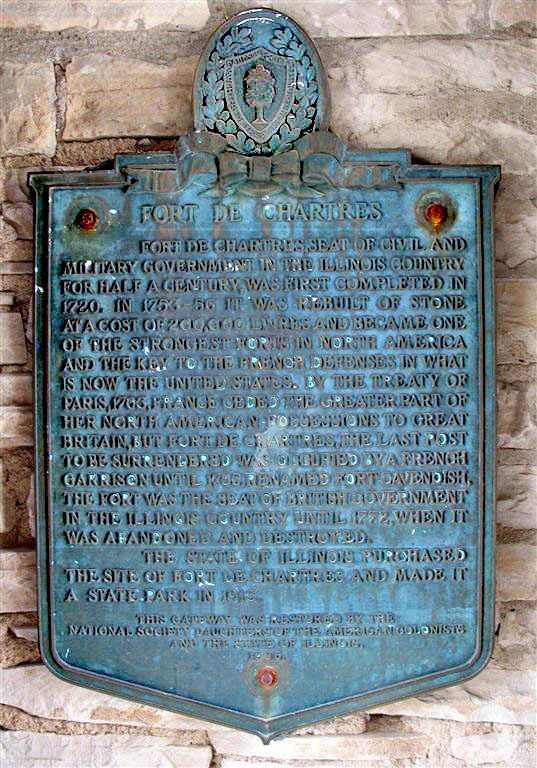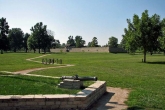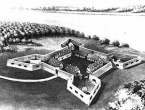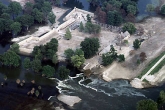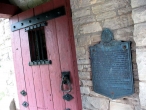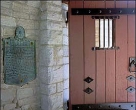13 OCTOBER 1936 — GATEWAY AT FORT DE CHARTRES
PRAIRIE DU ROCHER, ILLINOIS
THIS IS HIDDEN TEXT
FORT DE CHARTRES, SEAT OF CIVIL AND MILITARY GOVERNMENT IN THE ILLINOIS COUNTRY FOR HALF A CENTURY, WAS FIRST COMPLETED IN 1720. IN 1753—56 IT WAS REBUILT OF STONE AT A COST OF 200,000 LIVRES AND BECAME ONE OF THE STRONGEST FORTS IN NORTH AMERICA AND THE KEY TO THE FRENCH DEFENSES IN WHAT IS NOW THE UNITED STATES. BY THE TREATY OF PARIS, 1763, FRANCE CEDED THE GREATER PART OF HER NORTH AMERICAN POSSESSIONS TO GREAT BRITAIN, BUT FORT DE CHARTRES, THE LAST POST TO BE SURRENDERED WAS OCCUPIED BY A FRENCH GARRISON UNTIL 1765. RENAMED FORT CAVENDISH, THE FORT WAS THE SEAT OF BRITISH GOVERNMENT IN THE ILLINOIS COUNTRY UNTIL 1772, WHEN IT WAS ABANDONED AND DESTROYED.
THE STATE OF ILLINOIS PURCHASED THE SITE OF FORT CHARTRES AND MADE IT A STATE PARK IN 1913.
THIS GATEWAY WAS RESTORED BY THE NATIONAL SOCIETY, DAUGHTERS OF THE AMERICAN COLONISTS AND THE STATE OF ILLINOIS.
The National Society, Daughters of the American Colonists dedicated the Gateway which it had erected at Fort de Chartres near Prairie du Rocher, Illinois, on October 13, 1936.
The strategic point of Fort Chartres was recognized by LaSalle, who impressed the ministers of Louis XIV with its importance and suggested that a fort be built there in the Mississippi Valley, realizing that this part of the country was destined to become valuable and populous.
In 1718, Bienville, Governor of Louisiana, sent his cousin, Pierre Duque Boisbriant, to erect a fort for protection against the Spanish and English, both of whom had established settlements on the Atlantic Coast, and occasionally, pioneers of those nations were venturing as far West as the Mississippi River.
In 1720, the banner of France, the fleur-de-lis, was flying to the breeze over Fort Chartres, and it was named in honor of Due de Chartres, son of the Regent of France. Jean St. Ange du Belle Rive, a Canadian, was put in command of the Fort.
Families lived within the Fort, and since this was the most important French post in America, one writer calls it “little Paris”, for dapper young French officers were stationed here, and it is said many of the ladies danced in gowns made of material brought from France. Another social feature recorded is that the ladies assembled all the balcony over the Gateway to watch the drill on the parade grounds just outside the Fort.
Fort Chartres became the principal base of supplies in the West during French and Indian Wars. Then the power of France began to wane. The flower of Fort Chartres went down at Niagara. Surrender of Canada followed, but Fort Chartres held out for the French King. In 1763, Louis XV transferred Fort Chartres to Great Britain in the Treaty of Paris. At this time Pierre Laclede arrived from New Orleans, bringing a company of merchants in fur trade and established a post on the west side of the Mississippi. which he still believed was French soil. Many French families followed him, wishing to remain under the French Flag. This settlement was St. Louis. Thus Fort Chartres was the last place in America where the French Flag flew.
1765 – the Red Cross of St. George replaced the lilies of France. St. Ange du Belle Rive, with some of the men of the Fort, took a boat for St. Louis, where he joined the Spanish Garrison and was later appointed in command of the Spanish Fort in that village.
The Mississippi River was ever French and one writer says it could not tolerate English on its banks, so in 1772 high water swept away some of Fort Chartres. The British took refuge at Kaskaskia, and the fort was never occupied again.
An architect of the Department of Public Works of Illinois drew the plans for the Gateway after much research and a very careful study of gateways used by French Forts of that period. The stone for the original Gateway had been brought from the river bluffs nearby and the present Gateway has in it every piece found in excavation and some stone from the bluffs from which the French brought theirs.
The Gateway is about 25 feet tall and 40 feet wide. It is topped by a wooden roof such as gave shelter to sentries who manned the two canons pointing down the road. On either side of the gateway and its oaken doors, twin tablets have been placed, giving the history of the fort.
After the unveiling of the two tablets, one in English and one in French, the Gateway was presented to the State of Illinois.
